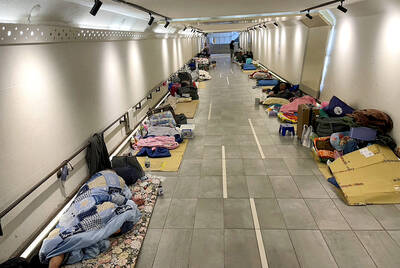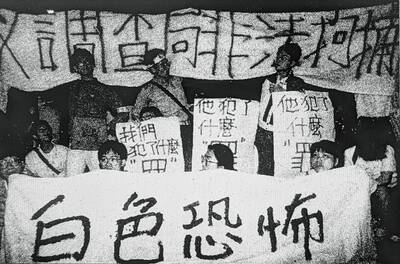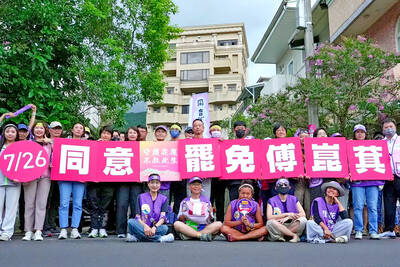For the past two centuries, Yingge has been known as the ceramics center of Taiwan. The town’s cobblestone-lined Yingge Old Street (鶯歌陶瓷老街), Japanese colonial-era architecture and world-class ceramics museum are all especially picturesque in the autumn sunshine.
According to local tradition, the seeds of Yingge’s flagship industry were planted when a potter from Guangzhou Province, Wu An
(吳鞍), settled in the area 200 years ago. The abundant forests and ample coal deposits around Yingge provided plenty of fuel for kilns and the city is still known for the manufacture of plumbing fixtures and cable insulators, as well as the abundance of ceramic dishware, fine-art pieces and kitsch available for tourists to purchase.
It takes about 30 minutes to arrive by train from Taipei Main Station, and most attractions are located within a 10-minute walk of Yingge’s train station on Wunhua Road (文化路), including Yingge Old Street, the heart of the town’s tourist district. As you walk westwards down Wunhua Road (sidewalks are in distressingly short supply, even among the busiest of Yingge’s streets, so stay alert, especially at corners), look to your left for the elaborate facades of several brick buildings constructed during Japanese colonial rule. The slightly derelict condition of the old Wang Yang (汪洋居) and Cheng Fa (成發居) residences only add to their ghostly charm.
To get to Yingge Old Street, continue down Wunhua Road until it splits off into Guocing Street (國慶街). Keeping an eye out for vehicles, cross the street and make a right on the footpath under the railway overpass. Hang a left on Jianshanbu Road (尖山埔路, Yingge Old Street’s official name), and follow the cluster of tourists up the hill.
Yingge Old Street is lined with more than 80 shops selling ceramic objects at a wide variety of price points. Teacups can be had for as little as NT$20, but Peter Wang (王淳興), an art supply store and studio owner who has worked in Yingge’s ceramic industry for 30 years, cautions that many of the goods are cheap imports from China.
“Tourists come to Yingge and sometimes they don’t have a positive impression about the quality of the items here. They come just expecting to find cheap bargains,” says Wang. He advises quality-minded shoppers to bypass stores stuffed with a mishmash of knickknacks and dishware and instead look for places that specialize in a particular type or style of ceramics. One such store that we saw as we strolled under the palms shading Yingge Old Street is Tai-Hwa Pottery (臺華窯) at 27 Jianshanbu Rd (尖山埔路27號), tel: (02) 8678-1600. The elegant, modern gallery exclusively carries ceramic pieces by Taiwanese artists.
No trip to Yingge is complete without a visit to the exceedingly photogenic Yingge Ceramics Museum (臺北縣立鶯歌陶瓷博物館) at 200 Wunhua Rd (文化路200號), tel: (02) 8677-2727, a marvel of modern architecture that has done the city proud since it opened in 2000. Admission is NT$100 for adults or NT$70 for students. Start with an informative and surprisingly entertaining exhibit on the history of ceramics in Yingge, and then head upstairs to see the four galleries of the Taiwan Ceramics Biennale, which runs through Dec. 7 and features 114 pieces from artists around the world. The artistic and technical mastery in the sculpture, which range from literal interpretations of the human form to abstract installations, will please ceramic connoisseurs and serves as an eye-opening introduction to the versatility of pottery as a fine art medium for neophytes.
The expansive park behind Yingge Ceramics Museum is also home to one of the most impressive (and effective) ploys to get children into a fine arts museum that I have ever seen: a giant, multi-level wading pool complete with gumball-like spherical sculptures and sprinklers, through which several very giddy kids were running during our recent visit.
While ceramic dinnerware is obviously in no short supply at Yingge, the city’s food scene is somewhat less bountiful. For lunch, we headed to the jam-packed Grandma’s Sushi (阿婆壽司) at 63 Jhongjheng 1st Rd (中正一路,63號), tel: (02) 2670-9345. The upstairs dining room was crowded with about 60 diners on a Sunday afternoon, while families posed for photos underneath the restaurant’s sign outside.
We picked up a mixed sushi plate (綜合壽司, NT$50) and a large serving of garlic-flavored cold noodles (蒜味涼麵, NT$35 or NT$50 depending on size). Despite the evident popularity of Grandma’s Sushi, we were underwhelmed by the sushi. Seafood is relatively sparse and ingredients consisted mostly of items like rou song (肉鬆, dried shredded pork), pickled vegetables and egg, which would have tasted fine had the rolls been made to order. Instead, all sushi is pre-made and packed into plastic containers. The cold noodles, which come with half of a preserved salty duck egg, were better.
If you get peckish on the way to the Ceramics Museum, stop by Yilanshi Bao Cun (宜蘭土包仔) at 128 Wunhua Rd (文化路128號), tel: (02) 8677-6498. A long line of people snaked out the front of the modest storefront, waiting patiently for fragrant buns and mantou stuffed with meat, veggies, red beans or sweet sesame paste. For dinner, we had beef noodles and three-cup chicken (三杯雞) at Taozhilu (陶之綠), which sits on the end of Yingge Old Street at 125 Jianshanbu Rd (尖山埔路125號), tel: (02) 8677-6498. Prices were a tad high — we paid a total of NT$200 for two meals with small cups of iced tea and a bowl of broth with a single, lonely meatball — but portions were hearty and palatable.
If a day spent looking at the work of master ceramic artisans leaves you feeling inspired, consider making a trip to Wang’s store, EZ Paint (輕鬆畫), at 207 Wunhua Rd (文化路207號), tel: (02) 2679-0486, near the train station. Wang originally ran a ceramics factory, but turned his business into a do-it-yourself studio and ceramics supply shop eight years ago. You can pick from a selection of 400 blank, unglazed ceramic pieces and paint them at home or at the studio. When your masterpiece is done, EZ Paint will coat your artwork in a chip-proof, non-toxic glaze and fire the piece for you, a process that takes about a week (the finished ceramic can be delivered to you).
Blank ceramics range in price from NT$35 for a simple teacup to NT$10,000 for a large, heavy vase attached to a rotating base. An additional, reasonable fee is charged for finishing. If you want to work on your piece at EZ Paint, NT$100 will buy you a full day at the shop’s comfortable cafe, with paints and brushes supplied.
The peaceful ambiance of the store is what attracted regular Stephanie Lai (賴秋吟) to it, and perhaps points to why Yingge continues to attract serious artists even as certain parts of it turn into tourist traps. Lai, who lives in nearby Sanxia and has been patronizing EZ Paint for two years, says that painting ceramics is a stress relief from her busy job as a corporate headhunter. On the day we visited, she was working on several pieces, including two mugs in a beautiful ombre rainbow pattern.
“Working on ceramics is very soothing and relaxing. I come away with a feeling of accomplishment,” says Lai.

From the last quarter of 2001, research shows that real housing prices nearly tripled (before a 2012 law to enforce housing price registration, researchers tracked a few large real estate firms to estimate housing price behavior). Incomes have not kept pace, though this has not yet led to defaults. Instead, an increasing chunk of household income goes to mortgage payments. This suggests that even if incomes grow, the mortgage squeeze will still make voters feel like their paychecks won’t stretch to cover expenses. The housing price rises in the last two decades are now driving higher rents. The rental market

July 21 to July 27 If the “Taiwan Independence Association” (TIA) incident had happened four years earlier, it probably wouldn’t have caused much of an uproar. But the arrest of four young suspected independence activists in the early hours of May 9, 1991, sparked outrage, with many denouncing it as a return to the White Terror — a time when anyone could be detained for suspected seditious activity. Not only had martial law been lifted in 1987, just days earlier on May 1, the government had abolished the Temporary Provisions Effective During the Period of National Mobilization for Suppression of the Communist

Hualien lawmaker Fu Kun-chi (傅?萁) is the prime target of the recall campaigns. They want to bring him and everything he represents crashing down. This is an existential test for Fu and a critical symbolic test for the campaigners. It is also a crucial test for both the Chinese Nationalist Party (KMT) and a personal one for party Chairman Eric Chu (朱立倫). Why is Fu such a lightning rod? LOCAL LORD At the dawn of the 2020s, Fu, running as an independent candidate, beat incumbent Democratic Progressive Party (DPP) lawmaker Hsiao Bi-khim (蕭美琴) and a KMT candidate to return to the legislature representing

Fifty-five years ago, a .25-caliber Beretta fired in the revolving door of New York’s Plaza Hotel set Taiwan on an unexpected path to democracy. As Chinese military incursions intensify today, a new documentary, When the Spring Rain Falls (春雨424), revisits that 1970 assassination attempt on then-vice premier Chiang Ching-kuo (蔣經國). Director Sylvia Feng (馮賢賢) raises the question Taiwan faces under existential threat: “How do we safeguard our fragile democracy and precious freedom?” ASSASSINATION After its retreat to Taiwan in 1949, the Chinese Nationalist Party (KMT) regime under Chiang Kai-shek (蔣介石) imposed a ruthless military rule, crushing democratic aspirations and kidnapping dissidents from